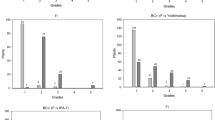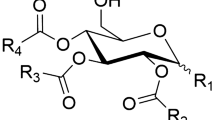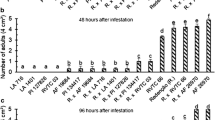Abstract
The fungal pathogen Alternaria alternata f. sp. lycopersici produces AAL-toxins that function as chemical determinants of the Alternaria stem canker disease in the tomato (Lycopersicon esculentum). In resistant cultivars, the disease is controlled by the Asc locus on chromosome 3. Our aim was to characterize novel sources of resistance to the fungus and of insensitivity to the host-selective AAL-toxins. To that end, the degree of sensitivity of wild tomato species to AAL-toxins was analyzed. Of all members of the genus Lycopersicon, only L. cheesmanii was revealed to be sensitive to AAL-toxins and susceptible to fungal infection. Besides moderately insensitive responses from some species, L. pennellii and L. peruvianum were shown to be highly insensitive to AAL-toxins as well as resistant to the pathogen. Genetic analyses showed that high insensitivity to AAL-toxins from L. pennellii is inherited in tomato as a single complete dominant locus. This is in contrast to the incomplete dominance of insensitivity to AAL-toxins of L. esculentum. Subsequent classical genetics, RFLP mapping and allelic testing indicated that high insensitivity to AAL-toxins from L. pennellii is conferred by a new allele of the Asc locus.
Similar content being viewed by others
References
Alexander LJ, Hoover MM (1955) Disease resistance in wild species of tomato. Ohio Agric Exp Stn Res Bull 752:1–76
Bino RJ, Franken J, Witsenboer HMA, Hille J, Dons JJM (1988) Effects of Alternaria alternata f. sp. lycopersici toxins on pollen. Theor Appl Genet 76:204–208
Bohn GW, Tucker CM (1939) Immunity to Fusarium wilt in the tomato. Science 89:603–604
Bournival BL, Scott JW Vallejos CE (1989) An isozyme marker for resistance to race 3 of Fusarium oxysporum f. sp. lycopersici in tomato. Theor Appl Genet 78:489–494
Bournival BL, Vallejos CE, Scott JW (1990) Genetic analysis of resistances to races l and 2 of Fusarium oxysporum f. sp. lycopersici from the wild tomato Lycopersicon pennellii. Theor Appl Genet 79:641–645
Caldas ED, Jones AD, Ward B, Winter CK, Gilchrist DG (1994) Structural characterization of three new AAL-toxins produced by Alternaria alternata f. sp. lycopersici. J Agric Food Chem 42:327–333
Chetelat RT, DeVerna JW (1991) Expression of unilateral incompatibility in pollen of Lycopersicon pennellii is determined by major loci on chromosomes 1, 6 and 10. Theor Appl Genet 82:704–712
Church GM, Gilbert W (1984) Genomic sequencing. Proc Natl Acad Sci USA 81:1991–1995
Clouse SD, Gilchrist DG (1987) Interaction of the asc locus in F8 paired lines of tomato with Alternaria alternata f. sp. lycopersici and AAL-toxin. Phytopathology 77:80–82
Clouse SD, Martensen AN, Gilchrist DG (1985) Rapid purification of host-specific pathotoxins from Alternaria alternata f. sp. lycopersici by solid-phase adsorption on octadecylsilane. J Chromatogr 350:255–263
De Vicente MC, Tanksley SD (1991) Genome-wide reduction in recombination of backcross progeny derived from male versus female gametes in an interspecific cross of tomato. Theor Appl Genet 83:173–178
Doolittle SP (1953) The use of wild Lycopersicon species for tomato disease control. Phytopathology 44:409–414
Eshed Y, Abu-abied M, Saranga Y, Zamir D (1992) Lycopersicon esculentum lines containing small overlapping introgressions from L. pennellii. Theor Appl Genet 83:1027–1034
Foolad MR, Jones RA (1993) Mapping salt-tolerance genes in tomato (Lycopersicon esculentum) using trait-based marker analysis. Theor Appl Genet 87:184–192
Fuson GB, Pratt D (1988) Effects of the host-selective toxins of Alternaria alternata f. sp. lycopersici on suspension-cultured tomato cells. Physiol Biochem 78:1641–1648
Gilchrist DG, Grogan RG (1976) Production and nature of a hostspecific toxin from Alternaria alternata f. sp. lycopersici. Physiol Biochem 66:165–171
Grogan RG, Kimble KA, Misaghi I (1975) A stem canker disease of tomato caused by Alternaria alternata f. sp. lycopersici. Phytopathology 65:880–886
Hammond-Kosack KE, Jones JDG (1994) Incomplete dominance of tomato Cf genes for resistance to Cladosporium fulvum. Mol Plant-Microbe Interact 7:58–70
Jones DA, Dickinson MJ, Balint-Kurti PJ, Dixon MS, Jones JDG (1993) Two complex resistance loci revealed in tomato by classical and RFLP mapping of the Cf-2, Cf-4, Cf-5, and Cf-9 genes for resistance to Cladosporium fulvum. Mol Plant-Microbe Interact 6:348–357
Koornneef M, Bade J, Hanhart C, Horsman K, Schel J, Soppe W, Verkerk R, Zabel P (1993) Characterization and mapping of a gene controlling shoot regeneration in tomato. Plant 13:131–141
Lamprecht SC, Marasas WFO, Alberts JF, Cawood ME, Gelderblom WCA, Shephard GS, Thiel PG, Calitz FJ (1994) Phytotoxicity of fumonisins and TA-toxin to corn and tomato. Phytopathology 84:383–391
Laterrot H (1976) Localisation chromosomique de I 2 chez la tomate contrôlant la résistance au pathotype 2 de Fusarium oxysporum f. lycopersici. Ann Amélior Plantes 26:485–491
Martin GB, Brommonschenkel SH, Chunwongse J, Frary A, Ganal MW, Spivey R, Wu T, Earle ED, Tanksley SD (1993) Map-based cloning of a protein kinase gene conferring disease resistance in tomato. Science 262:1432–1436
McGrath DJ, Gillespie D, Vawdrey L (1987) Inheritance of resistance to Fusarium oxysporum f. sp. lycopersici races 2 and 3 in Lycopersicon pennellii. Aust J Agric Res 38:729–733
Moussatos V, Witsenboer H, Hille J, Gilchrist D (1993) Behaviour of the disease resistance gene Asc in protoplasts of Lycopersicon esculentum Mill. Physiol Mol Plant Pathol 43:225–236
Overduin B, Hogenhout SA, Van der Biezen EA, Haring MA, Nijkamp HJJ, Hille J (1993) The Asc locus for resistance to Alternaria stem canker in tomato does not encode the enzyme aspartate carbamoyltransferase. Mol Gen Genet 240:43–48
Paddock EF (1950) A tentative assignment of Fusarium-immunity locus to linkage group 5 in tomato. Genetics 35:683–684
Rick CM (1969) Controlled introgression of chromosomes of Solanum pennellii into Lycopersicon esculentum: segregation and recombination. Genetics 62:753–768
Rommens CMT, Rudenko GN, Dijkwel PPD, Van Haaren MJJ, Ouwerkerk PBF, Blok KM, Nijkamp HJJ, Hille J (1992) Characterization of the Ac/Ds behaviour in transgenic plants using plasmid rescue. Plant Mol Biol 20:61–70
Sambrook J, Fritsch EF, Maniatis T (1989) Molecular cloning: a laboratory manual, 2nd edn. Cold Spring Harbor Laboratory Press, Cold Spring Harbor, New York
Sarfatti M, Katan J, Fluhr R, Zamir D (1989) An RFLP marker in tomato linked to the Fusarium oxysporum resistance gene I2. Theor Appl Genet 78:755–759
Sarfatti M, Abu-Abied M, Katan J, Zamir D (1991) RFLP mapping of I1, a new locus in tomato conferring resistance against Fusarium oxysporum f. sp. lycopersici race 1. Theor Appl Genet 82:22–26
Schwartz E, Shen D, Aebersold R, McGrath JM, Pichersky E, Green BR (1991) Nucleotide sequence and chromosomal location of Cab11 and Cab12, the genes for the fourth polypeptide of the photosystem I light-harvesting antenna (LHCI). FEBS Lett 280:229–234
Scott JW, Jones JP (1989) Monogenic resistance in tomato to Fusarium oxysporum f. sp. lycopersici race 3. Euphytica 40:49–53
Siler DJ, Gilchrist DG (1982) Determination of host-selective phytotoxins from Alternaria alternata f. sp. lycopersici as their maleyl derivatives by high-performance liquid chromatography. J Chromatogr 238:167–173
Siler DJ, Gilchrist DG (1983) Properties of host specific toxins produced by Alternaria alternata f. sp. lycopersici in culture and in tomato plants. Physiol Plant Pathol 23:265–274
Stam P (1993) Construction of integrated genetic linkage maps by means of a new computer package: JoinMap. Plant J 3:739–744
Stevens MA, Rick CM (1986) Genetics and breeding. In: Atherton JG, Rudich J (eds) The tomato crop, a scientific basis for crop improvement. Chapman and Hall, New York, pp 35–100
Tanksley SD, Ganal MW, Prince JP, de Vicente MC, Bonierbale MW, Broun P, Fulton TM, Giovannoni JJ, Grandillo S, Martin GB, Messeguer R, Miller JC, Miller L, Paterson AH, Fineda O, Röder MS, Wing RA, Wu W, Young ND (1992) High density molecular linkage maps of the tomato and potato genomes. Genetics 132:1141–1160
Taylor IB (1986) Biosystematics of the tomato. In: Atherton JG, Rudich J (eds) The tomato crop, a scientific basis for crop improvement. Chapman and Hall, New York, pp 1–34
Thomas CM, Jones DA, English JJ, Carroll BJ, Bennetzen JF, Harrison K, Burbidge A, Bishop GJ, Jones JDG (1994) Analysis of the chromosomal distribution of transposon-carrying TDNAs in tomato using the inverse polymerase chain reaction. Mol Gen Genet 242:573–585
Van der Beek JG, Verkerk R, Zabel P, Lindhout P (1992) Mapping strategy for resistance in tomato based on RFLPs between cultivars: Cf9 (resistance to Cladosporium fulvum) on chromosome 1. Theor Appl Genet 84:106–112
Van der Biezen EA, Overduin B, Kneppers TJA, Mesbah L, Nijkamp HJJ, Hille J (1994a) Molecular genetic characterisation of the Asc locus of tomato conferring resistance to the fungal pathogen Alternaria alternata f. sp. lycopersici. Euphytica 79:205–218
Van der Biezen EA, Overduin B, Nijkamp HJJ, Hille J (1994b) Integrated genetic map of tomato chromosome 3. Tomato Genet Coop Rep 44:8–10
Wang IF, Stall RE, Vallejos (1994) Genetic analysis of a complex hypersensitive reaction to bacterial spot in tomato. Phytopathology 84:126–132
Witsenboer HMA, Schaik CE, Bino RJ, Löffler HIM, Nijkamp HJJ, Hille J (1988) Effects of Alternaria alternata f. sp. lycopersici toxins at different levels of tomato plant cell development. Plant Sci 56:253–260
Witsenboer HMA, Van de Griend EG, Tiersma JB, Nijkamp HJJ, Hille J (1989) Tomato resistance to Alternaria stem canker: localization in host genotypes and functional expression compared to non-host resistance. Theor Appl Genet 78:457–462
Witsenboer HMA, Kloosterziel KM, Hateboer G, Nijkamp HJJ, Hille J (1992) Tomato susceptibility to Alternaria stem canker: parameters involved in host-specific toxin-induced leaf necrosis. Plant Sci 81:127–134
Author information
Authors and Affiliations
Additional information
Communicated by H. Saedler
Rights and permissions
About this article
Cite this article
van der Biezen, E.A., Glagotskaya, T., Overduin, B. et al. Inheritance and genetic mapping of resistance to Alternaria alternata f. sp. lycopersici in Lycopersicon pennellii . Molec. Gen. Genet. 247, 453–461 (1995). https://doi.org/10.1007/BF00293147
Received:
Accepted:
Issue Date:
DOI: https://doi.org/10.1007/BF00293147




